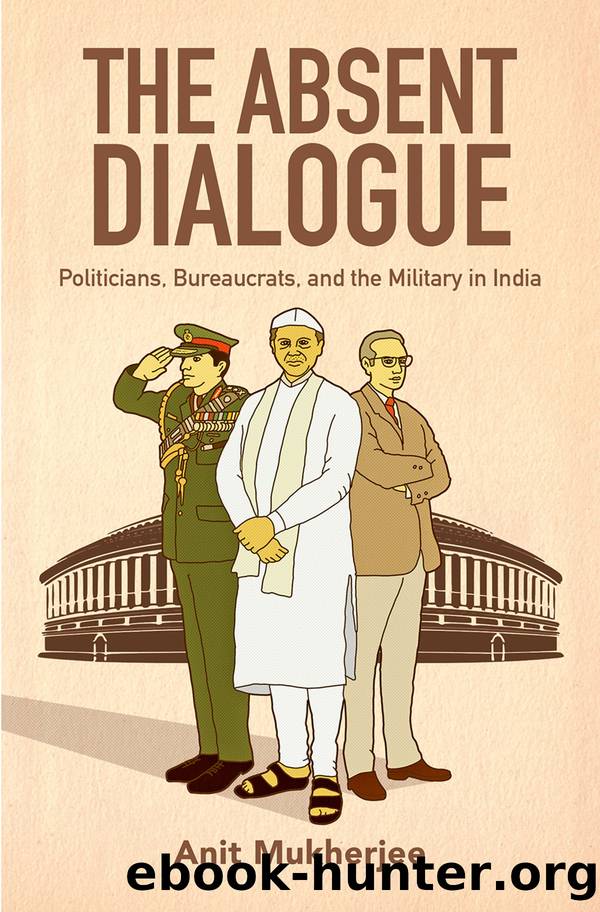The Absent Dialogue by Mukherjee Anit;

Author:Mukherjee, Anit;
Language: eng
Format: epub
Publisher: Oxford University Press USA - OSO
Published: 2019-04-15T00:00:00+00:00
The AirâLand Battle: The 1999 Kargil War
The 1999 Kargil war was triggered by the intrusion of Pakistani troops across the Line of Control in Kashmir. The Indian Navy was on high alert during this conflict and played an important role in signaling resolve, but this was primarily an airâland operation. Indicative of the difference in ordnance usage, the air force dropped around 500 bombs, whereas the artillery alone fired over 250,000 shells, bombs, and rockets. According to some estimates, over 83% of Pakistanâs 466 fatalities were caused by combined infantry and artillery fire and 1% were due to air strikes.104 Despite the difference in scale, however, this was a combined airâland battle which revealed three main problems pertaining to jointness.
First was the acrimonious relationship between the army and the air force at the highest levels in New Delhi. One of the enduring controversies of the war was regarding the promptness of the air force in responding to army requests for close air support. The prevalent view in the army is that the air force dithered over their requests for support. According to an officer who served in the Operations Directorate, âin one of the early COSC meetings held at the Military Operations Room, Air Chief Marshal Tipnis almost gave a shut up call to the VCOAS [vice chief of army staff] who was requesting for air support.â105 Air force officers, on the other hand, argue that the army was not clear or forthcoming about the operational picture and was making unrealistic demands, like using attack helicopters in high-altitude areas.106 These tensions were partially resolved when chief of army staff General V. P. Malik returned from his foreign visit and lobbied the other chiefs to present a joint plan to their political leaders.107 However, this episode set the tone, and the war of words between the two services and the bitterness reverberate to this day.108 The initial tensions and bitterness added to the interservice rivalry and, in turn, encouraged single-service narratives to the conflict. All the same, many participants observed that while relations were stained at senior levels, at the functional level, especially in the lower formation headquarters, they worked well as a team.109
The second and perhaps more important problem was in the execution of joint operations as they revealed lacunae in the joint planning process, information sharing, and execution. The problems with joint planning started from the top, with the service chiefs in the COSC. The views of the services could not be more different as General V. P. Malik claimed that the COSC is the âworst organization for joint planning,â110 while a senior air force officer who was present at the meetings called it âa very effective body.â111 This divergence reflected an institutional divide on the proper model for jointness as the air force prefers to continue the âcoordinationâ model and the army argues for the âco-optionâ one, preferably under its control. Other than problems at the highest level, there were issues at the functional level of planning. The
Download
This site does not store any files on its server. We only index and link to content provided by other sites. Please contact the content providers to delete copyright contents if any and email us, we'll remove relevant links or contents immediately.
| Anthropology | Archaeology |
| Philosophy | Politics & Government |
| Social Sciences | Sociology |
| Women's Studies |
Cecilia; Or, Memoirs of an Heiress — Volume 1 by Fanny Burney(31327)
Cecilia; Or, Memoirs of an Heiress — Volume 3 by Fanny Burney(30929)
Cecilia; Or, Memoirs of an Heiress — Volume 2 by Fanny Burney(30886)
The Great Music City by Andrea Baker(21197)
We're Going to Need More Wine by Gabrielle Union(18067)
Bombshells: Glamour Girls of a Lifetime by Sullivan Steve(13102)
Pimp by Iceberg Slim(12924)
All the Missing Girls by Megan Miranda(12741)
Fifty Shades Freed by E L James(12445)
Norse Mythology by Gaiman Neil(11877)
Talking to Strangers by Malcolm Gladwell(11865)
Crazy Rich Asians by Kevin Kwan(8343)
Mindhunter: Inside the FBI's Elite Serial Crime Unit by John E. Douglas & Mark Olshaker(7831)
The Lost Art of Listening by Michael P. Nichols(6465)
Enlightenment Now: The Case for Reason, Science, Humanism, and Progress by Steven Pinker(6404)
Bad Blood by John Carreyrou(5763)
The Four Agreements by Don Miguel Ruiz(5504)
Weapons of Math Destruction by Cathy O'Neil(5032)
We Need to Talk by Celeste Headlee(4863)
